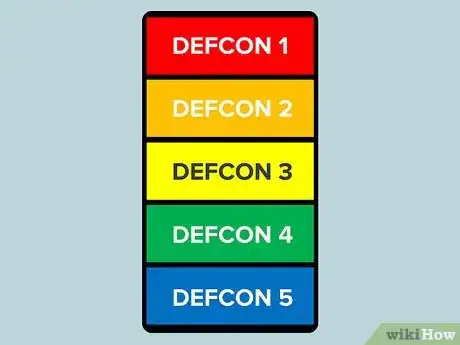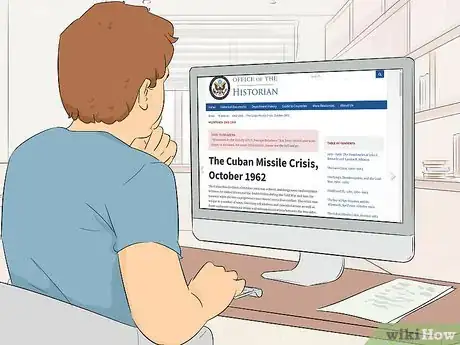wikiHow is a “wiki,” similar to Wikipedia, which means that many of our articles are co-written by multiple authors. To create this article, 18 people, some anonymous, worked to edit and improve it over time.
There are 10 references cited in this article, which can be found at the bottom of the page.
wikiHow marks an article as reader-approved once it receives enough positive feedback. This article received 15 testimonials and 86% of readers who voted found it helpful, earning it our reader-approved status.
This article has been viewed 706,314 times.
Learn more...
The United States' DEFCON (short for "defense readiness condition") scale is a measure of the level of alertness of the nation's defense forces. The DEFCON scale uses a minimum of 5 (for normal peacetime status) and a maximum of 1 (for situations of global severity, like nuclear war). It's important to understand the DEFCON system both as a matter of self-education and to avoid inaccurate usage (i.e., "We're about to go to DEFCON six.")
Steps
DEFCON Reference Chart
| DEFCON Level | Level of Readiness | Historical Precedent |
|---|---|---|
| 5 | Normal peacetime readiness; | General "baseline" level during times of peace |
| 4 | Increased intelligence-gathering and security measures | Sporadically throughout Cold War, War on Terror |
| 3 | Armed forces readiness increased above normal levels; Air Force ready to mobilize in 15 minutes | Post-9/11 Attacks (2001), Yom Kippur War (1973), Operation Paul Bunyan (1976), Post-Four Power Talks (1960) |
| 2 | High readiness; armed forces ready to deploy in six hours | Cuban Missile Crisis (1962) |
| 1 | Maximum readiness; all forces ready for combat; nuclear war imminent or likely | None |
DEFCON Levels
-
1Learn how to read the DEFCON scale. The DEFCON scale is a way of assigning a numerical value to the readiness of the American military. Higher DEFCON values are used for lower levels of readiness (during more peaceful situations), while lower DEFCON values are used for higher levels of readiness (during tenser situations where the possibility of military action is more likely). A DEFCON level of 5 corresponds to ordinary peacetime, while a DEFCON level of 1 (which has never been reached) corresponds to the most dangerous situations, like thermonuclear war.
- Note that different branches of the military can be issued different DEFCON levels. For instance, during the Cuban Missile Crisis, which is generally considered one of the tensest moments in American military history, the Strategic Air Command went on DEFCON 2, while the rest of the military went on DEFCON 3.[2]
-
2Use DEFCON 5 for peacetime. A DEFCON level of 5 is a very good thing — this is the condition used to designate normal peacetime military readiness. At a DEFCON 5, the US military takes no wide-scale precautionary defense measures beyond what is ordinarily required.
- Note that DEFCON 5 isn't necessarily a sign that the world is at peace — conflicts, even major ones, may be occurring around the world during a DEFCON 5. However, in this case, the military judges that these events pose no significant defense threats.
Advertisement -
3Use DEFCON 4 for heightened alertness. DEFCON 4 is the first level of readiness above the baseline value of DEFCON 5 and thus constitutes a fairly mild increase in readiness (though an increase from DEFCON 5 to DEFCON 4 is certainly significant). This DEFCON level signifies increased intelligence-gathering efforts and, sometimes, the heightening of national security measures. However, it is not usually an indication that the military (or the nation) are in imminent danger of attack.
- In the modern world, it is thought that DEFCON 4 is sometimes issued after minor to moderate terrorist attacks and politically-motivated killings, or after would-be plots are uncovered. Presumably, this is done in anticipation of further violence as an attempt to prepare for and prevent it.
-
4Use DEFCON 3 for tense military/political situations. Situations that call for DEFCON 3 are serious — though they may not pose an immediate threat to the existence or stability of the American state, they do call for significant vigilance. At this level, American military forces are put on a heightened state of alert in anticipation of mobilization — in particular, the Air Force is kept ready to launch operations with just 15 minutes of notice. In addition, all military communications may be encrypted based on classified protocols.
- Historically, DEFCON 3 has usually corresponded to situations in which military action against the US or one of its allies was a distinct possibility. For instance, during Operation Paul Bunyan, which resulted in a DEFCON 3, two American officers were killed by North Korean forces in the Korean Demilitarized Zone (DMZ). In this case, a DEFCON 3 was issued because of the possibility that any errors in the resulting standoff might trigger open war across the Korean border (a politically and militarily tense area then, as it is today).[3]
-
5Use DEFCON 2 for major threats. DEFCON 2 refers to a further increase in force readiness just below maximum readiness. Combat forces are readied for major operations within just a few hours. An increase to DEFCON 2 is very serious — these situations carry a significant risk of major military operations against the United States or its allies, including the use of nuclear weapons. DEFCON 2 is typically reserved for all but the most militarily tense of international situations.
- The most notable time that DEFCON 2 has ever been issued was during the Cuban Missile Crisis, although this declaration was limited to Strategic Air Command. It is though that this is the only time that a wide-scale DEFCON 2 alert has been issued, though, since DEFCON-related information is usually kept classified, it is not exactly certain how many times this level of readiness has been reached.[4]
-
6Use DEFCON 1 for maximum alertness. DEFCON 1 refers to maximum military readiness — it is thought that forces with a DEFCON level of 1 are kept ready for immediate action at all times. DEFCON 1 is reserved for the absolute most dangerous, severe situations, including imminent or ongoing nuclear war involving the US or one of its allies.
- Though, as noted above, DEFCON levels are usually kept classified until after the fact, it is thought that DEFCON 1 has never been issued for a branch of the US military before.
- Some limited, unverifiable evidence suggests that DEFCON 1 may have been triggered for certain military units during the first Gulf War. If these claims are true, however, they only applied to individual units and not to entire branches of the military.
DEFCON Background
-
1Understand how DEFCON levels are assigned. The exact process that the military uses to declare a DEFCON increase is not perfectly-understood by the public. It is usually assumed that an upgrade in military preparedness is made by the Joint Chiefs of Staff (the highest commanders in the American military) with the approval of the president. However, some anecdotal evidence suggests that top-level military leaders are able to increase the DEFCON level without the president — for instance, some sources report that the Strategic Air Command's decision to issue a DEFCON 2 during the Cuban Missile Crisis occurred without input from President Kennedy.[5]
- Note again that the precise actions that the military takes at each DEFCON level are, for obvious reasons, kept secret. Thus, most of the information that the general public has on the DEFCON scale is based on old declassified documents or historical DEFCON "spikes" revealed to the public after the fact. Though some non-military, non-government sources may claim to know the current DEFCON level, there is no way to verify this.[6]
-
2Be aware of other US alert scales. The DEFCON scale is not the only measure that the US government and military use to rate their readiness against external and internal dangers. These include LERTCON (used by the US and NATO allies), REDCON (used by individual US military units), and more.[7] [8] However, the most important alert scale besides DEFCON is likely the EMERGCON scale. These conditions (which have never been issued before) are thought to be issued in the event of nuclear war and include civilian directives as well as military ones. EMERGCON has two levels, which are:
- Defense Emergency: Made in the event of major hostile attacks against U.S. or allied forces overseas. Issued by unified commander or higher authority.[9]
- Air Defense Emergency: Made in the event of attacks against the US, Canada, or military installations in Greenland. Issued by the Commander in Chief of the North American Aerospace Defense Command.[10]
- Note that, by definition, all military forces go to DEFCON 1 in the event of an EMERGCON being issued.
-
3Research the history of the DEFCON scale. Though much of the DEFCON scale's history is kept secret for obvious reasons, the declassified information that is available to the public is fascinating in its own right. Conceived in the late 1950s as a means of coordinating NORAD defense efforts between the U.S. and Canada, the DEFCON system has gone through several changes between its creation and its current form today.
- For instance, the original DEFCON scale had "sub-categories" for several DEFCON levels: "Charlie" and "Delta" under DEFCON 4 and "Alpha" and "Bravo" for DEFCON 3. In addition, it had an "Emergency" level above DEFCON 1 that greatly resembled the EMERGCON scale described above.
Community Q&A
-
QuestionHas America or Canada ever gone to DEFCON 1?
 Community AnswerNo, DEFCON 1 is used in the event of nuclear war or if EMERGCON is declared by NAT (which implies nuclear war).
Community AnswerNo, DEFCON 1 is used in the event of nuclear war or if EMERGCON is declared by NAT (which implies nuclear war). -
QuestionAre there any websites where I can get the current Defcon/lefcon/redcon status?
 Community AnswerDEFCON has an infrequently updated website, but it does not show all information, so for real time status updates, no.
Community AnswerDEFCON has an infrequently updated website, but it does not show all information, so for real time status updates, no. -
QuestionWere the Allies at Defcon 1 during World War 2?
 Community AnswerThe Defcon system was implemented after the end of WW2, so the Allies did not have this type of system during the war and therefore did not use it. However, the Allied countries "Declared War" on the Axis countries. "Declaring War" is an official act of a government and, within the United States, it is only done so by an act of Congress. Once a nation has declared that it is at war, many laws and rules come in to play that change how it works and how it functions.
Community AnswerThe Defcon system was implemented after the end of WW2, so the Allies did not have this type of system during the war and therefore did not use it. However, the Allied countries "Declared War" on the Axis countries. "Declaring War" is an official act of a government and, within the United States, it is only done so by an act of Congress. Once a nation has declared that it is at war, many laws and rules come in to play that change how it works and how it functions.
References
- ↑ http://www.northcom.mil/Portals/28/Documents/Supporting%20documents/%28U%29%201962%20NORAD%20CONAD%20History%20Jan-Jun.pdf
- ↑ http://fas.org/nuke/guide/usa/c3i/defcon.htm
- ↑ http://www.globalsecurity.org/military/ops/paul_bunyan.htm
- ↑ http://www.defensemedianetwork.com/stories/cuban-missile-crisis-50th-anniversary-consensus-announcement-and-defcon-2/
- ↑ https://history.state.gov/milestones/1961-1968/cuban-missile-crisis
- ↑ http://www.defconwarningsystem.com/
- ↑ http://books.google.com/books?id=dzKr3mSKyIgC
- ↑ http://books.google.com/books?id=T6T0LDe0WyoC
- ↑ http://everything2.com/title/DEFENSE+EMERGENCY
About This Article
In the U.S., the DEFCON scale is used to measure how alert the country’s defense forces are in response to a potential national emergency. DEFCON is short for Defense Ready Condition. To understand the DEFCON scale, start by getting to know the levels. There are 5 DEFCON levels, with 5 being the least severe and 1 being the most severe. DEFCON level 5 is defined as normal peacetime readiness. This level is used when the country is not at war and there are no major potential threats to national security. DEFCON 4 is a slightly elevated level of readiness, characterized by an increase in intelligence gathering and heightened security measures. The U.S. armed forces might go to DEFCON 4 in response to potential terrorist activity or military threats, but it doesn’t necessarily mean that there’s immediate danger of an attack. Level 3 is used during tense political or military situations where it might be necessary to mobilize the country’s armed forces at any moment—for instance, if there’s a chance that the U.S. or one of its allies is under threat of military action. At DEFCON 3, the Air Force is always ready to mobilize within just 15 minutes of notice. DEFCON 2 is used for severe situations, such as when there’s a major terrorist attack or immediate danger of a major military action against the United States or its allies. At DEFCON 2, all of the country’s combat forces are set to deploy within about 6 hours of notice. DEFCON 1 is the most severe level, which is used for extreme situations, such as an outbreak of nuclear war. When the U.S. military is at DEFCON 1, all armed forces are supposed to be ready for immediate action at all times. Since DEFCON information is classified, it’s not clear whether the U.S. has ever reached DEFCON 1 status. The DEFCON scale is used in combination with other emergency readiness scales, such as LERTCON, REDCON, and EMERGCON. Keep in mind that while there’s some general information about the DEFCON scale available to the general public, the details of how DEFCON levels are decided—and what actions the country’s armed forces take in reaction to each level—are classified. For examples of each of these DEFCON levels, keep reading!









-Step-10-Version-3.webp)























































